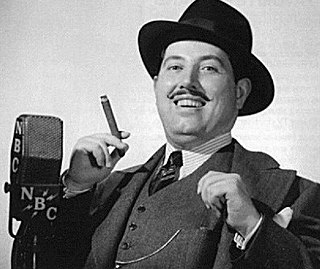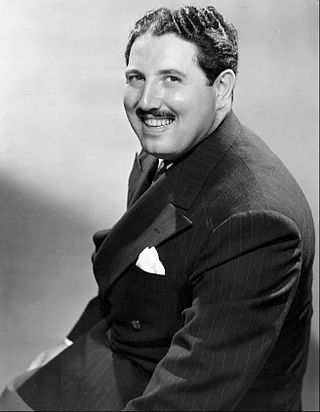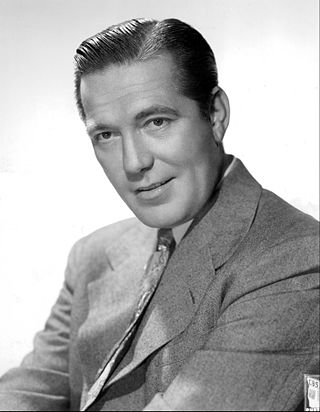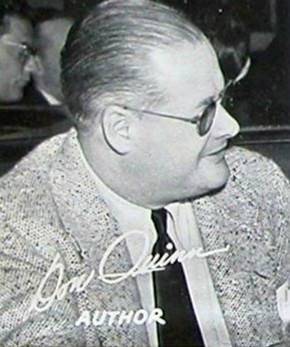
Fibber McGee and Molly (1935–1959) was a longtime husband-and-wife team radio comedy program.

Arthur Quirk Bryan was an American actor and radio personality. He is best remembered for his longtime recurring role as well-spoken, wisecracking Dr. Gamble on the radio comedy Fibber McGee and Molly and for voicing the Warner Bros. cartoon character Elmer Fudd.

The Great Gildersleeve is a radio situation comedy broadcast in the United States from August 31, 1941 to 1958. Initially written by Leonard Lewis Levinson, it was one of broadcast history's earliest spin-off programs. The series was built around Throckmorton P. Gildersleeve, a regular character from the radio situation comedy Fibber McGee and Molly. The character was introduced in the October 3, 1939, episode of that series. Actor Harold Peary had played a similarly named character, Dr. Gildersleeve, on earlier episodes. The Great Gildersleeve enjoyed its greatest popularity in the 1940s. Peary played the character during its transition from the parent show into the spin-off and later in four feature films released at the height of the show's popularity.

James Edward Jordan was the American actor who played Fibber McGee in Fibber McGee and Molly and voiced the albatross Orville in Disney's The Rescuers (1977).

Lux Radio Theatre, sometimes spelled Lux Radio Theater, a classic radio anthology series, was broadcast on the NBC Blue Network (1934–35) ; CBS Radio network (1935–54), and NBC Radio (1954–55). Initially, the series adapted Broadway plays during its first two seasons before it began adapting films. These hour-long radio programs were performed live before studio audiences. The series became the most popular dramatic anthology series on radio, broadcast for more than 20 years and continued on television as the Lux Video Theatre through most of the 1950s. The primary sponsor of the show was Unilever through its Lux Soap brand.

Harold "Hal" Peary was an American actor, comedian and singer in radio, films, television, and animation. His most memorable role is as Throckmorton P. Gildersleeve, which began as a supporting character on radio's "Fibber McGee and Molly" in 1938.
The Halls of Ivy is an American situation comedy that ran from 1950 to 1952 on NBC radio, created by Fibber McGee & Molly co-creator/writer Don Quinn. The series was adapted into a CBS television comedy (1954–55) produced by ITC Entertainment and Television Programs of America. British husband-and-wife actors Ronald Colman and Benita Hume starred in both versions of the show.

Marlin Hurt was an American stage entertainer and radio actor who was best known for originating the dialect comedy role of Beulah made famous on the Fibber McGee and Molly program and the first season of the Beulah radio series.
A spin-off or spinoff is any narrative work derived from an already existing work that focuses on different aspects from the original work.

Blondie is a radio situation comedy adapted from the long-running Blondie comic strip by Chic Young. It stars Arthur Lake as Dagwood Bumstead and, for the majority of its run, Penny Singleton as Blondie Bumstead. The radio program ran on several networks from 1939 to 1950.

Kenneth Lorin Darby was an American composer, vocal arranger, lyricist, and conductor. His film scores were recognized by the awarding of three Academy Awards and one Grammy Award. He provided vocals for the Munchkinland mayor in The Wizard of Oz (1939), who was portrayed in the film by Charlie Becker. Darby is also notable as the author of The Brownstone House of Nero Wolfe (1983), a biography of the home of Rex Stout's fictional detective.

Don Quinn was an American comedy writer who started out as a cartoonist based in Chicago. According to sources, Quinn's career as a cartoonist was short-lived but his career as a writer began after he realized that the magazines and newspapers threw away his drawings he sent in but kept his captions.

Look Who's Laughing is a 1941 American comedy film directed by Allan Dwan It was produced and distributed by RKO Pictures. The film is built around a number of radio stars from the Golden Age of Radio and centers around radio personality Jim Jordan as Fibber McGee from the comic duo, Fibber McGee and Molly, who plans to build an aircraft factory in a small town. Look Who's Laughing was followed by Here We Go Again (1942), with many of the radio stars reprising their performances. It is also known by the alternative title Look Who's Talking.

Here We Go Again is a 1942 American film, a sequel to Look Who's Laughing. With RKO in financial trouble, with the success of the earlier zany comedy starring a bevy of radio stars, Here We Go Again put Fibber McGee and Molly in a search for where to celebrate the couple's 20th anniversary. They want to throw a big party but when everyone declines their invitation, they decide to go on a second honeymoon instead.
Heavenly Days is a 1944 film starring Fibber McGee and Molly. It was the third and final feature film to feature the popular radio characters; unlike the two previous entries, none of the radio show's supporting cast members appeared in this film except the show's house vocal quartet, The King's Men.

Marian Irene Driscoll Jordan was an American actress and radio personality. She was most remembered for portraying the role of Molly McGee, the patient, common sense, honey-natured wife of Fibber McGee on the NBC radio series Fibber McGee and Molly from 1935 to 1959. She starred on this series opposite her real-life husband Jim Jordan.
Smackout was an American old-time radio series and was arguably the first and earliest example of the situation comedy (sitcom) genre and format. The series revolves around a general store in Chicago and the store's proprietor Luke Gray, played by Jim Jordan. Whenever a customer came into the general store to ask Uncle Luke, as Gray was affectionately known, for something, the typical response from Luke would be "we're smack out of that". But that never stopped Luke from telling one of his signature tall tales to the customer. Jordan also played a regular customer named Jim and Marian Jordan portrayed the main roles as Teeny, a little girl and regular customer, and Marian, Jim's girlfriend.

Patrick McGeehan was an American actor.
Hap Hazard is an American old-time radio comedy-variety program that was broadcast on NBC-Red beginning on July 1, 1941 and on CBS beginning in January 1942.













